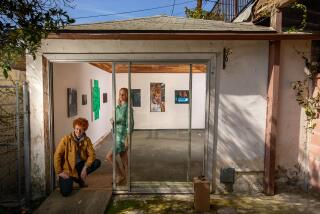Going for Broke? Not O.C.’s Arts Scene
- Share via
Will Orange County’s worst-ever financial crisis affect the local arts scene?
Will higher taxes, which many foresee being implemented to bail out the bankrupt county, make a night at the theater seem ridiculously unaffordable and unconscionably frivolous?
Will the mere fear of such measures make season-ticket holders scratch the words “renew subscription” off their to-do lists? Will donors forgo contributions?
Will cash-starved schools cancel every last art, music, dance or drama class they have left?
Or will we see none of the above?
That’s what area arts leaders are wondering. With $198.1 million in the county investment fund, Irvine is the most heavily invested city, and Toni Pang, supervisor of the Irvine Fine Arts Center, is worried.
“If the city is looking at cutting programs, it is something for us or any city program to be very concerned about,” Pang says.
Still, neither Pang nor anyone else has a firm idea of whether the early December nightmare that has kept public officials up nights will dim the lights on the arts as well.
So, as of this moment, the biggest blip on an otherwise news-lite year remains the Laguna Art Museum’s surprise March 29 firing of Charles Desmarais, its director. The move blindsided many.
“Deeply surprised” was the way Michael Botwinick, director of the Newport Harbor Art Museum, characterized his reaction at the time.
Laguna museum trustees, who fired Desmarais without cause (as permitted by his contract) after he had been at the helm for 5 1/2 years, said only that they wanted “more help and energy to be put in administration.”
*
Meanwhile the board, which has steadfastly refused to elaborate, has three finalists in the search for Desmarais’ replacement and expects to hire a new director next month. (Curator of exhibitions and acting director Susan M. Anderson didn’t apply for the job.)
The county’s most prominent arts administrator, Tom Tomlinson, in October marked his first anniversary as the Orange County Performing Arts Center’s president.
Tomlinson has won widespread praise for his performance and has begun to push the center’s programming envelope, but has yet to veer dramatically from its four-pronged policy of booking musical theater, dance, opera and classical music.
By all accounts, however, he has shown a willingness to make the facility more accessible to a wider spectrum of the public and strengthen relations between the center and county performing arts groups that use it.
Tomlinson and other center officials have been meeting with Orange County Together, a group sponsored by the United Way and the Orange County Human Relations Commission, to promote understanding among races and cultures. And, Tomlinson has made offers of collaborative programming to the center’s three major users: the Pacific Symphony, the Orange County Philharmonic Society and Opera Pacific.
“We have great cooperation” with the center, said Philharmonic Society executive director Dean Corey, who also celebrated his first year in a new post.
Financially, 1994 didn’t start off as a blockbuster year for the center. In January it announced that it had ended 1993 with the smallest surplus--at $205,284, less than half of the previous year’s--since opening eight years ago. Tomlinson and other center officials, however, called the smaller surplus “inconsequential,” especially in light of the recession gripping the country. We’ll have to wait until year-end figures are released next month to know how the rest of ’94 went.
In money matters elsewhere, no large or mid-size arts organizations went belly-up, as in bleak bygone years, but there wasn’t much to grand jete about either.
The high point, perhaps, came in September when the California Arts Council awarded 11 county groups a total of $328,892--50% more than it gave the same number of groups in 1993. That was due in part to fewer organizations applying for subsidies statewide, council officials said, but eight of the county’s 11 won larger grants nonetheless.
On the downside, the Anaheim-based Leo Freedman Foundation, which has doled out millions to local arts groups since 1991, didn’t award any new grants. The foundation, owner of the Celebrity Theatre, hasn’t rented the theater for months and thus has had to shoulder the costs of its upkeep.
“We’ve had less income with which to make grants,” Ellis Stern, a foundation trustee, said last week. “We hope to have a lease signed in the next couple of weeks” and issue new grants again next December.
Elsewhere, Newport Harbor Art Museum rearranged its office hours to save on utilities and security bills in the most recent move in a series of cutbacks. Staffers will work just as many hours but will no longer work on Mondays, when galleries are closed to visitors. Instead, they’ll clock in every other Saturday and work an hour longer on weekdays.
The museum still has no date to begin its expansion into the vacated Newport Beach Public Library next door. It has, however, raised about $1 million in cash and pledges for the project. The total amount of money needed has been pegged at roughly $6 million, though plans may be revised this summer when officials have a better idea of “how successful we are” in raising the money, director Botwinick said.
Hoping to strengthen its financial position, the Muckenthaler Cultural Center in Fullerton last month began weaning itself from city support. By 1997, 50% of its operational costs will be transferred to the private Muckenthaler Cultural Center Foundation. The theory is that donors will give more to an institution that lacks support from the city of Fullerton, which has cut the center’s funding by about 30% during the past three years.
One small organization, Costa Mesa’s 3-year-old Backstage Theatre, did close its doors in ‘94, but not because of money woes, at least not directly. Producer Al Valletta wanted to stage shows in Los Angeles, and the company suffered poor attendance here. A new storefront drama troupe, the Theatre District, has opened at the Backstage’s former site.
The new Grove Center Theatre company set up shop in Garden Grove’s Gem Theatre and Festival Amphitheatre, former home of GroveShakespeare, which dissolved in 1993. Officials at the new organization said they plan to produce an eclectic array of 175 performances a year.
*
Also, the Laguna Playhouse finally got the green light to turn an old South Laguna bank building into a 250-seat Second Stage theater, expected to open next year, and Santa Ana’s Bowers Museum of Cultural Art last week welcomed inaugural visitors to Kidseum, a hands-on children’s museum two blocks away.
The opening of the Huntington Beach Art Center, which has been delayed repeatedly over the past four years, was put off yet again, although three key staffers were hired to run it. Late March is the revised debut date.
Further expanding the county’s cultural offerings, Little Saigon strengthened its prominence on the arts scene when, in May, a group of Vietnamese Americans announced plans for Project 20, a series of cultural events here and around the country in 1995. The events celebrate next spring’s 20th anniversary of the start of the largest wave of Vietnam War refugees to arrive in the U.S.
Some of the country’s major arts organizations, such as the Smithsonian Institution, have staged or plan to stage exhibits containing works by county Vietnamese artists, who also have made major inroads in music, recording, literary and other industries.
Meanwhile, the realm of popular culture provided some upbeat news. Fullerton Museum Center, the only local museum to break an attendance record this year, did so with its guitar-studded ode to native son Leo Fender. The exhibit, organized by the center, sought to illustrate how the pioneer electric-guitar designer created instruments that led to a new kind of rock music. It drew 12,500 visitors, besting by 900 the 1991 “Titanic” show that also ran for nearly four months.
The county’s punk-rock scene, which dates back to 1978, generated a huge national hit when The Offspring from Huntington Beach produced the biggest-selling album in the history of the independent-alternative rock movement. “Smash” has sold more than 3 million copies to date.
*
With top-price tickets at a record-setting $350 each, Barbra Streisand didn’t sell out all her shows at The Pond of Anaheim, but fans, from as far away as Alaska, waxed rhapsodic and snatched up $25 Streisand T-shirts and $60 ties. Her half-dozen concerts in June and July were part of Streisand’s first tour in nearly 30 years and the tour she said would be her last.
As concert-goer Susan Bratlein of North Dakota put it at the time: “I’m just so excited, I don’t know what to say.”
Managers of the Irvine Barclay Theatre knew exactly what to say when last month the widow of the theater’s most prominent donor announced she wouldn’t pay the remaining $600,000 of her late husband’s $1-million pledge: Sue you.
Richard H. Barclay put the family name on the theater with his bequest, which helped complete construction of the facility. He paid the first two annual installments, totaling $400,000. After he died in 1992, however, the payments stopped. Operators sued the Barclay estate last month. The suit states that in exchange for the Barclay’s $1-million gift, the theater agreed to bear their name.
The Barclay debacle didn’t seem to faze other arts administrators, who said they are not fearful that Marjorie Barclay’s action will give other donors and their heirs ideas, thereby threatening millions of promised dollars their groups have yet to receive.
Of course, all that was before the County of Orange filed for protection under Chapter 9 Bankruptcy.
Happy New Year.
More to Read
The biggest entertainment stories
Get our big stories about Hollywood, film, television, music, arts, culture and more right in your inbox as soon as they publish.
You may occasionally receive promotional content from the Los Angeles Times.










